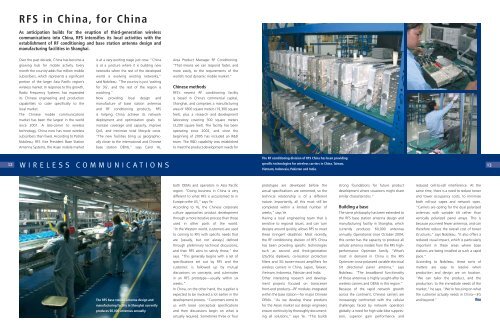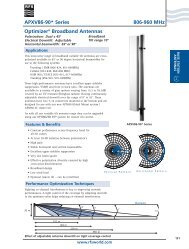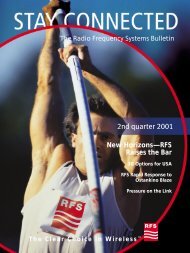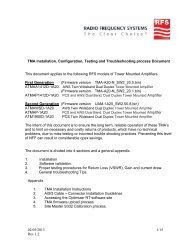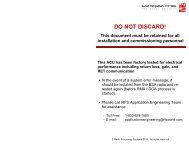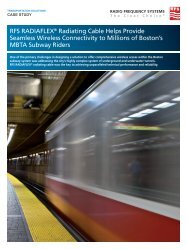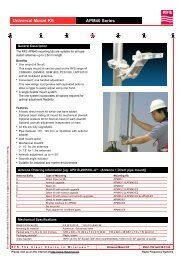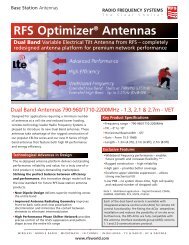Download - Radio Frequency Systems
Download - Radio Frequency Systems
Download - Radio Frequency Systems
Create successful ePaper yourself
Turn your PDF publications into a flip-book with our unique Google optimized e-Paper software.
RFS in China, for China<br />
As anticipation builds for the eruption of third-generation wireless<br />
communications into China, RFS intensifies its local activities with the<br />
establishment of RF conditioning and base station antenna design and<br />
manufacturing facilities in Shanghai.<br />
Over the past decade, China has become a<br />
growing hub for mobile activity. Every<br />
month the country adds five million mobile<br />
subscribers, which represents a significant<br />
portion of the larger Asia Pacific region’s<br />
wireless market. In response to this growth,<br />
<strong>Radio</strong> <strong>Frequency</strong> <strong>Systems</strong> has expanded<br />
its Chinese engineering and production<br />
capabilities to cater specifically to the<br />
local market.<br />
The Chinese mobile communications<br />
market has been the largest in the world<br />
since 2001. A late-comer to wireless<br />
technology, China now has more wireless<br />
subscribers than fixed. According to Patrick<br />
Nobileau, RFS Vice President Base Station<br />
Antenna <strong>Systems</strong>, the Asian mobile market<br />
is at a very exciting stage just now. “China<br />
is at a juncture where it is building new<br />
networks when the rest of the developed<br />
world is evolving existing networks,”<br />
said Nobileau. “The country is just ‘waiting<br />
for 3G’, and the rest of the region is<br />
watching.”<br />
Now providing local design and<br />
manufacture of base station antennas<br />
and RF conditioning products, RFS<br />
is helping China achieve its network<br />
deployment and optimization goals: to<br />
increase coverage and capacity, improve<br />
QoS, and minimize total lifecycle costs.<br />
“The new facilities bring us geographically<br />
closer to the international and Chinese<br />
base station OEMs,” says Carol Ye,<br />
Area Product Manager RF Conditioning.<br />
“That means we can respond faster, and<br />
more easily, to the requirements of the<br />
world’s most dynamic mobile market.”<br />
Chinese methods<br />
RFS’s newest RF conditioning facility<br />
is based in China’s commercial capital,<br />
Shanghai, and comprises a manufacturing<br />
area of 1800 square meters (19,300 square<br />
feet), plus a research and development<br />
laboratory covering 300 square meters<br />
(3,200 square feet). The facility has been<br />
operating since 2002, and since the<br />
beginning of 2005 has included an R&D<br />
team. The R&D capability was established<br />
to meet the product development needs for<br />
WIRELESS COMMUNICATIONS<br />
The RF conditioning division of RFS China has been providing<br />
12 specific technologies for wireless carriers in China, Taiwan,<br />
13<br />
Vietnam, Indonesia, Pakistan and India.<br />
The RFS base station antenna design and<br />
manufacturing facility in Shanghai currently<br />
produces 60,000 antennas annually.<br />
both OEMs and operators in Asia Pacific<br />
region. “Doing business in China is very<br />
different to what RFS is accustomed to in<br />
Europe orthe US,” says Ye.<br />
According to Ye, the Chinese corporate<br />
culture approaches product development<br />
through a more iterative process than those<br />
used in other parts of the world.<br />
“In the Western world, customers are used<br />
to coming to RFS with specific needs that<br />
are [usually, but not always] defined<br />
through preliminary technical discussions,<br />
and then RFS aims to satisfy those,” she<br />
says. “This generally begins with a set of<br />
specifications set out by RFS and the<br />
customer; is followed up by mutual<br />
discussions on concepts; and culminates<br />
in an RFS prototype—usually within six<br />
weeks.”<br />
In China, on the other hand, the supplier is<br />
expected to be involved a lot earlier in the<br />
development process. “Customers come to<br />
us with loose conceptual specifications<br />
and then discussions begin on what is<br />
actually required. Sometimes three or four<br />
prototypes are developed before the<br />
actual specifications are cemented, so the<br />
technical relationship is of a different<br />
nature. Importantly, all this must still be<br />
completed within a limited number of<br />
weeks,” says Ye.<br />
Having a local engineering team that is<br />
sensitive to regional issues, and can turn<br />
designs around quickly, allows RFS to meet<br />
these stringent deadlines. Most recently,<br />
the RF conditioning division of RFS China<br />
has been providing specific technologies<br />
such as second and third-generation<br />
(2G/3G) diplexers, co-location protection<br />
filters and 3G tower-mount amplifiers for<br />
wireless carriers in China, Japan, Taiwan,<br />
Vietnam, Indonesia, Pakistan and India.<br />
Other interesting research and development<br />
projects focused on transceiver<br />
front-end products—RF modules integrated<br />
within the base station—for major Chinese<br />
OEMs. “As we develop these products<br />
for the Asian market our design engineers<br />
ensure continuity by thoroughly documenting<br />
all solutions,” says Ye. “This builds<br />
strong foundations for future product<br />
development where situations might share<br />
similar characteristics.”<br />
Building a base<br />
The same philosophy has been extended to<br />
the RFS base station antenna design and<br />
manufacturing facility in Shanghai, which<br />
currently produces 60,000 antennas<br />
annually. Operational since October 2004,<br />
this center has the capacity to produce all<br />
cellular antenna models from the RFS highperformance<br />
Optimizer family. “What’s<br />
most in demand in China is the RFS<br />
Optimizer cross-polarized variable electrical<br />
tilt directional panel antenna,” says<br />
Nobileau. “The broadband functionality<br />
of these antennas is highly sought-after by<br />
wireless carriers and OEMs in this region.”<br />
Because of the rapid network growth<br />
across the continent, Chinese carriers are<br />
increasingly confronted with the cellular<br />
challenges faced by network operators<br />
globally: a need for high side-lobe suppression,<br />
superior gain performance and<br />
reduced cell-to-cell interference. At the<br />
same time, there is a need to reduce tower<br />
and tower occupancy costs, to minimize<br />
both roll-out capex and network opex.<br />
“Carriers are opting for the dual polarized<br />
antennas with variable tilt rather than<br />
vertically polarized panel arrays. This is<br />
because you need fewer antennas, and can<br />
therefore reduce the overall cost of tower<br />
structures,” says Nobileau. “It also offers a<br />
reduced visual impact, which is particularly<br />
important in these areas where base<br />
stations are being installed at such a rapid<br />
pace.”<br />
According to Nobileau, these sorts of<br />
matters are easy to resolve when<br />
production and design are on location.<br />
“We can tailor the product, and the<br />
production, to the immediate needs of the<br />
market,” he says. “We’re focusing on what<br />
the customer actually needs in China—3G<br />
and beyond.”


